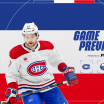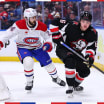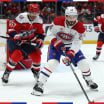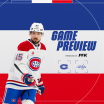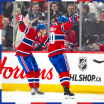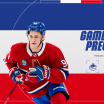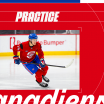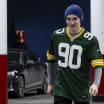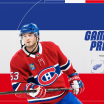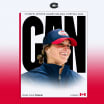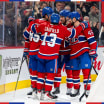Setting the table for Habs-Pens
Marc Dumont dissects the upcoming Qualifying Round series between the Penguins and Canadiens

15 points separated the two clubs when the regular season was on hold, comfortably placing the Canadiens in the underdog role, a role that served them well last time these two teams met in the playoffs, back in 2010.
Can the Canadiens repeat their triumphant performance? Time will tell, but the challenges remain very similar for Les Glorieux.
While there's no doubt both Sidney Crosby and Evgeni Malkin have added a little proverbial pepper to their hair color in recent years, they still remain among the best players in the world. Elite, game-breaking talents that will push the Canadiens' 5-on-5 dominance to the limit.
In stark contrast, the Canadiens are one of the youngest teams in the tournament, whereas the Penguins are among the oldest, and consequently, one of the most experienced.
The juxtaposition does not end there.
Top-line facts
In contrast to their opponents, the Canadiens distribute their ice time relatively consistently, in a bid to wear down opposing teams thanks to a relentless forecheck and seemingly limitless energy.
But there's one line that stands out above the rest at 5-on-5, and that notion applies for the rest of the NHL, as well.
Few are aware of just how dominant they can be, but the Canadiens' top trio ranks among the best in the League when it comes to generating offense, and consequently, keeping the puck 200 feet away from their goaltender -- the ultimate defensive strategy.
Wait? Did he just say they're a dominant line?
Oh yes.
Let me explain.
The Tomas Tatar, Phillip Danault, Brendan Gallagher line doesn't quite reach the same point production levels as some other top NHL trios, mostly due to Danault's stalwart presence on the penalty kill. That much we know. But another way of looking at it is that they don't pad their stats by scoring on the man advantage.
This line does their damage at 5-on-5, where the vast majority of the game is played, and the proof is in the numbers.
The statistics, while impressive on their own, should come with a quick explanation.
Any time you manage to control over 50 percent of the shots, scoring chances and goals, there are very good odds you are helping your team win games.
If you can push those numbers closer to 55 percent, you're giving your team a significant edge in puck control.
If you can come anywhere close to 60 percent, you've struck gold.
Over the course of the last two seasons, the Canadiens' top line has managed to control over 61 percent of the shots, 63 percent of the high-danger scoring chances, and 62 percent of the goals while they're on the ice.
A different way of exploring their stats is breaking it down into plus-minus.
They're plus-613 in shots, plus-143 in high-danger chances, and plus-30 in goals, all the while facing the highest level of competition available.
How do they do it?
It's a matter of perfect chemistry in their case, as the sum of their parts results in a perfectly-balanced line.
Danault is often typecast as a defensive center, but his penchant for supporting the outlet pass down low, winning puck battles, and finding open ice in the offensive zone should not be ignored.
Tomas Tatar, who quietly led the Canadiens in scoring this season, is an absolute wizard in the neutral zone. His positioning leads to a bevy of turnovers, often leading to high-danger chances for the line. But his excellent positioning is not limited to the neutral zone. He uses his creativity and vision to generate chances for himself and his teammates in the offensive zone.
Last season, no other NHL player was on the ice for a larger percentage of shots fired than Tatar, though Gallagher, hockey's version of a honey badger/Tommy gun hybrid, was not too far behind, ranking second in the League.
He unquestionably epitomizes hard work, but there's also a certain method to Gallagher's madness, and it involves hunting down shooting opportunities like a honey badger hunts down its favourite snack. Just substitute stinging bees for angry defensemen.
He leads all forwards in 5-on-5 shots by a significant margin over the last three seasons. In fact, he leads all NHL forwards in many key statistical categories over that time, including the aforementioned shots, high-danger chances, rush attempts, and rebounds created, which explains why only three other players, Auston Matthews, Alex Ovechkin, and Leon Draisaitl, have scored more 5-on-5 goals than Gallagher since 2017-18.
Most of the Canadiens' offense flows through that line, which puts the onus for the offensive charge squarely on their shoulders. But since they'll surely garner a lot of attention, Claude Julien will need a constant flow of secondary and tertiary scoring to help out throughout the series, and answer a lot of pressing questions.
Will Max Domi elevate his game with his first taste of NHL postseason action? Can Nick Suzuki tap into his playoff magic from the 2018-19 OHL playoffs? Can Artturi Lehkonen rekindle his postseason prowess from the 2015-16 SHL playoffs? Is Jesperi Kotkaniem ready to take the next step in his offensive game?
Given the length of the series, it may very well come down to whichever team taps into its scoring depth the fastest.
Carey that weight
On the defensive side of things, the Canadiens will be led by a trio of veterans, in Jeff Petry, captain Shea Weber, and Ben Chiarot, all three of whom have the ability to not only control the play, but provide a significant amount of offense from the back end.
The most interesting matchups might occur on the third pairing, where a group of very promising young players, including Noah Juulsen and Cale Fleury, are vying for a spot in the lineup. The aforementioned players bring a unique blend of physical play and offensive firepower, which could inject crucial youthful exuberance into the lineup.
But as per usual, at least defensively speaking, success will come down to Carey Price's ability to shut down some of the best forwards in the history of the League.
Judging by goals saved above average (GSAA), Price outperformed Matt Murray by a significant margin this season, but the same cannot be said for Tristan Jarry, which adds yet another interesting layer to the goaltending situation.
As for high-danger shots, Price maintained a higher save percentage in that particular situation than his counterparts, which should come in handy given the elite shooting talent he'll face in the series.
Final Word
While there's a lot to be said about the value of a well-rounded team versus a top-heavy lineup, there's no doubt the Canadiens will have a steep hill to climb if they're to beat the favored Penguins. Just like in 2010, they'll have to rely on a complete team effort, paired with a few game-breaking standouts, to make it through. They'll also have to improve their special teams play, and they won't have much time to do it.
It won't be easy, especially given the dearth of playoff experience in the lineup, but as we all know, especially those of us who delve into statistics with regularity, there's a reason the game takes place on the ice, and not in a simulation.
It's the same reason most of us fell in love with hockey in the first place; anything can happen once the puck is dropped.
Game on!
All statistics are 5-on-5 unless otherwise specified, via [NaturalStatTrick.com.]



